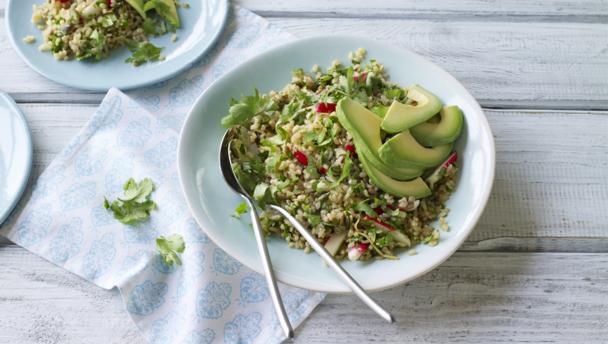

By Nigella Lawson
Sometimes also called an avocado pear, the avocado is the fruit of the Persea Americana tree, which is native to the subtropical regions of the American continent. It has green, buttery flesh and a large central stone. In Britain, two main avocado varieties are available: Hass and Fuerte. The Hass variety has a knobbly purple-black exterior and a creamy-textured, richly flavoured interior; the Fuerte variety has a smooth green skin. Avocados are very high in both protein and oil. The avocado has the highest protein and oil content of any fruit. In fact, this soft-fleshed fruit can contain up to 30 per cent fat. Don't let the high fat content put you off, though; avocados contain only monounsaturated fat, which may help to reduce the risk of cancer and heart disease.
 Fish tacos
Fish tacos
 Smoky bean chilli with quinoa
Smoky bean chilli with quinoa
 Rice bowl with ginger, radish and avocado
Rice bowl with ginger, radish and avocado
 Black bean and brown rice bowl with poached eggs
Black bean and brown rice bowl with poached eggs
 Socca pancakes with roasted peppers and avocado
Socca pancakes with roasted peppers and avocado
 Avocado, tomato, feta and brown rice grain bowl
Avocado, tomato, feta and brown rice grain bowl
 Baked eggs in avocado with pitta
Baked eggs in avocado with pitta
 Smashed avocado on toast
Smashed avocado on toast
 Avocado hummus
Avocado hummus
 Prawn cocktail
Prawn cocktail
 Caribbean toastie cups with avocado, mango and mint
Caribbean toastie cups with avocado, mango and mint
 Chickpea flatbreads with tasty toppings
Chickpea flatbreads with tasty toppings
 Chocolate avocado shake
Chocolate avocado shake
 Real guacamole
Real guacamole
These days, as well as growing throughout Central and South America, the avocado also thrives in parts of Africa, Australia, Israel and the Canaries. Look for avocadoes that have unblemished skins with no soft spots, which suggest bruising. They are ready to eat when the flesh yields slightly when pressed with the thumb.
Extra virgin avocado oil is now widely available in UK supermarkets. Use it as you would olive oil, for roasting and drizzling over salads; or serve it as a dip with crusty bread.
When it comes to cooking, the Mexican dip called guacamole is without a doubt the best-known avocado dish. But Mexicans use avocados in a wide array of other dishes, from ceviche to tacos. In some parts of Mexico, avocado leaves are toasted and ground to imbue dishes with an anise flavour. In the Philippines, savoury-sweet avocado ice cream is popular.
Avocados must be allowed to ripen in a warm place before they’re used; speed up the process by wrapping them in brown paper. To test ripeness, press the skin lightly with your thumb. If it feels slightly yielding, it’s ready to eat. Cut lengthways down to the stone and twist to separate the two halves. Pierce the stone carefully with a knife to embed the knife’s tip, then pull the stone out.
The yellow-green flesh should come away from the skin easily, but it will go brown when exposed to air, so always prepare avocados just before serving or drench in lemon juice to prevent the browning. The trick is to combine avocado with ingredients that will enhance its nuttiness but cut back on its richness. Savour the pale flesh for breakfast or lunch by crushing it on toasted sourdough bread along with a squeeze of lime juice, sea salt and pepper. Or make it into a coarse salsa with tomatoes, onion, chilli, lime and coriander to accompany grilled meats. Alternatively, toss the creamy wedges gently in a salad with green leaves, crabmeat, spring onions and a little lemon.
Type the ingredients you want to use, then click Go. For better results you can use quotation marks around phrases (e.g. "chicken breast"). Alternatively you can search by chef, programme, cuisine, diet, or dish (e.g. Lasagne).